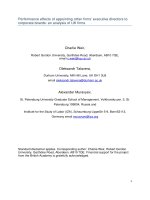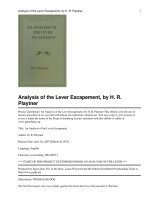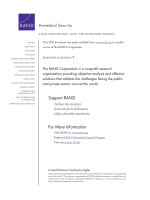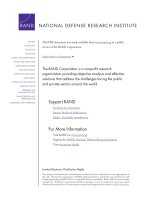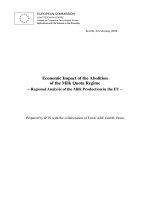An analysis of woronin body biogenesis in neurospora crassa
Bạn đang xem bản rút gọn của tài liệu. Xem và tải ngay bản đầy đủ của tài liệu tại đây (7.89 MB, 197 trang )
AN ANALYSIS OF WORONIN BODY BIOGENESIS IN NEUROSPORA CRASSA
NG SENG KAH
(B.Sc. (Hons), NUS)
A THESIS SUBMITTED
FOR THE DEGREE OF DOCTOR OF PHILOSOPHY
TEMASEK LIFE SCIENCES LABORATORY
NATIONAL UNIVERSITY OF SINGAPORE
2009
ii
Acknowledgements
I would like to thank my advisor, Dr Gregory Jedd, for giving me the opportunity to work
on this project and for his valuable guidance and support throughout the course of this
work.
I thank my thesis committee, Prof. Mohan Balasubramanian, Dr. Naweed Naqvi and Dr.
Wang Yue for their comments and suggestions.
Many thanks to current and past members of the Comparative Genomic Laboratory , Cell
Division Laboratory, Cell Dynamic Laboratory and Cell Stress and Homeostasis
Laboratory, especially Snezhana, Davis, Liling, Liang Ming, Yuen Chyao, Tsui Han,
Guillaume, Nurzian, Chia Ling, Wan Zhong, Ting Gang and Wilson for their generous
help and stimulating discussions which provide a fruitful, friendly and enjoyable
environment.
I would also like to thank Temasek Life Sciences Laboratory facilities and staff for
general support.
Lastly, I thank my friends and family members for their emotional support through the
years, especially my beloved wife, Songyu, for her encouragement and loving support.
iii
TABLE OF CONTENTS
Page
TITLE PAGE……………………………………………………………… ……….……i
ACKNOWLEDGEMENTS………………………………………………… ………… ii
TABLE OF CONTENTS……………….……………………………………… ………iii
SUMMARY……………………………………………………………… … ………viii
LIST OF FIGURES……………………………………………………………… …… x
LIST OF TABLES………………………………………………………………… … xii
LIST OF ABBREVISTIONS…………………………………………………… …….xiii
LIST OF PUBLICATIONS……………………………………………… ……………xiv
CHAPTER 1: INTRODUCTION
1.1 Peroxisome and its functions
1.1.1 Biogenesis of peroxisomes………………………… ……………………………1
1.1.2 Specialization of the peroxisome…………………………… ………………… 3
1.2 The Kingdom Fungi
1.2.1 Phylogenetic distribution of fungi……………………………………….……… 4
1.2.2 The fungal mycelium…………………………………………………….……… 6
1.2.3 Woronin Body
1.2.3.1 History of Woronin body research……………………………….……… 7
1.2.3.2 Identification and function of HEX protein…………………….……… 7
1.2.3.3 Appearance of Woronin bodies…………………………………… … 10
1.2.3.4 Crystal structure of the Woronin body core in Neurospora crassa…… 12
1.2.4 Proteins involved in Woronin body biogenesis
1.2.4.1 The HEX sorting receptor, WSC……………………………………… 13
1.2.4.2 Peroxins………………………………………………………………….13
1.3 Organelle segregation
1.3.1 Importance of proper organelle segregation…………………………………… 14
1.3.2 Mechanisms of organelle segregation
1.3.2.1 Mitochondria…………………………………………………………… 16
1.3.2.2 Peroxisomes …………………………………….………………………18
1.3.2.3 Vacuole / Lysosome…………………………………………………… 20
iv
1.4 Thesis objectives.……………………………………………………………….22
CHAPTER 2: METHODS AND MATERIALS
2.1 Neurospora crassa and other fungi
2.1.1 Fungal strains…………………………………………………………………….23
2.1.2 Growth media……………………………………………………………………26
2.2 Genetic and molecular methods
2.2.1.1 Measurement of growth rate…………………………………………….27
2.2.1.2 Measurement of hyphae diameter……………………………………….27
2.2.2 Identification of the leashin (lah) gene
2.2.2.1 Identification of lah by screening Neurospora crassa gene deletion
library……………………………………………………………………………28
2.2.2.2 Identification of lah by crude genetic mapping…………………… … 28
2.2.2.3 Identification of lah by rapid genetic mapping………………………….28
2.2.2.4 Identification of lah by cosmid library………………………………… 29
2.2.3 Mating of Neurospora crassa strains……………………………………………30
2.2.4 Generation of spheroplasts and Neurospora crassa transformations……………31
2.2.5 Magnaporthe grisea transformations
2.2.5.1 Tansformations of plasmids into Agrobacteria………………………… 32
2.2.5.2 Magnaporthe grisea transformations…………………………………….32
2.2.6 Generation of DNA fragments for homologous recombination
2.2.6.1 Marker fusion tagging (MFT)……………………………………………33
2.2.6.2 Truncation of lah gene………………………………………………… 40
2.2.6.3 Identification of lah-2 activation sequences…………………………… 40
2.2.7 Reverse transcriptase-PCR (RT-PCR)………………… ……………………….42
2.2.8 Amplify the tandem repeats fragments in lah……………………………… ….44
2.2.9 Anastomosis assay……………………………………………………………….45
2.2.10 Measurement of protoplasmic bleeding………………………………………….45
2.3 Escherichia coli and agrobacterium
2.3.1 Bacteria and agrobacterium strains………………………………………………45
2.3.2 Plasmids………………………………………………………………………….46
2.3.3 Bacterial transformation, growth, maintenance and selection of Escherichia coli
and agrobacterium…………………………………………………………………….….47
2.4 Protein molecular biology and Microscopy
2.4.1 Confocal fluroscence microscopy……………………………………………… 48
2.4.2 Transmission electron microscopy………………………………………………48
2.4.3 Quantification of Woronin body…………………………………………………49
2.4.4 Antibodies……………………………………………………………………… 49
2.4.5 Cellular fractionation
v
2.4.5.1 Differential centrifugation……………………………………………….50
2.4.5.2 Nycodenz density gradient centrifugation……………………………….51
2.4.5.3 Chemicals treatment of the WSC protein……………………………… 51
2.4.5.4 Biochemistry analysis of the LAH protein………………………………52
2.4.5.5 Analysis of lipid rafts by flotation……………………………………….52
CHAPTER 3: Isolation and characterization of leashin (lah)
3.1 Identification of the Woronin body biogenesis defect mutant lah
3.1.1 Identification of the lah mutant by visual screening of a deletion strain library 53
3.1.2 Identifying lah by genetic mapping, CAPs markers and complementation using a
cosmid library……………………………………………………………………54
3.1.3 lah encodes the largest predicted protein in Neurospora crassa……………… 58
3.1.4 Characterization of the lah mutant……………………………………………….60
3.2 Characterization of LAH
3.2.1 An N-terminal domain of LAH physically associates with the Woronin body….62
3.2.2 LAH requires the C-terminal domain of WSC for Woronin body localization….62
3.2.3 Woronin body associated LAH is detergent insoluble………………………… 65
3.2.4 The 3’ region of the predicted lah locus is not involved in Woronin body
inheritance……………………………………………………………………… 67
3.3 Marker fusion tagging (MFT), a new method to produce chromosomally encoded
fusion proteins……………………………………………………………………69
3.3.1 LAH MFT tags localize to distinct compartments……………………………….71
3.3.2 Evidence that lah encodes two independent transcriptional units……………….72
3.4 Characterization of lah-1 and lah-2
3.4.1 Identification of new introns in the lah locus……………………………………74
3.4.2 Identification of a C-terminal domain of lah-1 that is required for tethering… 75
3.4.3 Identification of the lah-2 promoter…………………………………………… 80
3.5 Disscussion
3.5.1 Model of Woronin body biogenesis…………………………………………… 82
3.5.2 Identification of a new component of Woronin body biogenesis machinery……84
3.5.3 LAH-1 functions as a Woronin body tether…………………………………… 84
3.5.4 Why are LAH proteins so large? 86
3.5.5 Incomplete splicing of lah gene………………………………………………….86
3.5.6 What is the receptor that recognizes Woronin bodies at the cell cortex? 87
3.5.7 Septal pore cap performs similar functions in the Basidiomycetes phyla……….88
CHAPTER 4: Function of LAH-2
4.1 LAH-2 is involved in growth…………………………………………………….90
vi
4.2 Genetic interaction between lah-2 and poc-7……………………………………93
4.3 Microtubules and nuclei in the Δlah-2 strain………………… ……………… 96
4.4 Discussion
4.4.1 LAH-2 is required for organized colonial growth……………………………….99
4.4.2 Why is the Δlah-2 strain highly vacuolated? 100
4.4.3 Function of the highly conserved C-terminal end of LAH-2………………… 101
4.4.4 Potential functions of the repeats in LAH-2……………………………………101
4.4.5 LAH-2 and the septal pore…………………………………………………… 102
4.4.6 LAH-2 and its potential interacting partners at the apical tip………………… 103
CHAPTER 5: Evolution of Woronin body tethering
5.1 Localization of Woronin body in filamentous fungi
5.1.1 Two patterns of Woronin body localization in filamentous fungi…………… 107
5.1.2 Neurospora and Sordaria recently evolved a derived pattern of Woronin body
localization…………………………………………………………………… 107
5.1.3 Deletion of intervening sequences in Neurospora crassa lah using MFT…… 112
5.1.4 LAH-1/2 fusion strain exhibits ancestral localization pattern of the Woronin
body…………………………………………………………………………… 112
5.1.5 Localization of Woronin body in LAH-1/2 fusion strain depends on wsc…… 113
5.2 Magnaporthe grisea lah
5.2.1 Tagging of N-terminal region of Magnaporthe grisea lah by MFT suggest a
single tether…………………………………………………………………… 115
5.2.2 Localization of Magnaporthe grisea lah in conidia and appresorium………….116
5.3 Discussion
5.3.1 Model for evolution of lah…………………………………………………… 119
5.3.2 Localization of Magnaporthe grisea LAH supports our hypothesis a single
ancestral tether………………………………………………………………….122
5.3.3 Function of ancestral lah……………………………………………………… 122
CHAPTER 6: Biochemical analysis of WSC
6.1 Characterization of WSC using biochemical methods
6.1.1 WSC interacts with Woronin bodies……………………………………………124
6.1.2 WSC is detergent insoluble…………………………………………………… 127
6.1.3 MDDS analogue mutation of WSC is sensitive to detergent………………… 128
6.1.4 WSC complex is not associated with lipid raft…………………………………130
6.2 Discussion
6.2.1 WSC is resistant to detergent treatment……………………………………… 132
vii
6.2.2 HEX and WSC are found in only a sub-population of peroxisomes ………….132
6.2.3 MDDS analogue mutation of WSC is non-functional………………………….133
6.2.4 WSC is like a tetraspanin……………………………………………………….135
REFERENCES…………………………………………………………………………137
Appendices
A. Anastomosis assay…………………………………………………………… 148
B. Tandem repeats of Neurospora crassa lah and evolution…………………… 150
viii
Summary
Eukaryotic organelles evolve to support the lifestyle of evolutionarily related organisms.
In the fungi, filamentous Ascomycetes possess dense-core organelles called Woronin
bodies (WBs). These organelles originate from peroxisomes and perform an adaptive
function to seal septal pores in response to cellular wounding.
Previously, it was found that WBs are centered on a self-assembled HEX1 protein in N.
crassa. A WB specific membrane protein WSC that is required for WB biogenesis has
been identified recently to envelope HEX assemblies at the peroxisome membrane and
help them bud from the peroxisome matrix. Also, it is known that cortical association of
WB requires WSC.
I conducted a screen for proteins associated with WB biogenesis and identified Leashin
(LAH) protein. Using genetic, cellular and biochemical methods, I show that Leashin
encodes an organellar tether required for WB inheritance. In addition, I associate
Leashin with evolutionary variation in the subcellular pattern of WB distribution.
In Neurospora, the leashin locus encodes two related adjacent genes. I named the 5’ gene
lah-1 and the downstream gene lah-2. The N-terminal sequences of LAH-1 bind WBs via
the WB–specific membrane protein WSC, and C-terminal sequences are required for WB
inheritance by cell cortex association. LAH-2 is localized to the hyphal apex and septal
pore rim and plays a role in colonial growth.
ix
In most species, WBs are tethered directly to the pore rim. However, Neurospora and
relatives have evolved a delocalized pattern of cortex association. Using a new method
for the construction of chromosomally encoded fusion proteins, marker fusion tagging
(MFT), I show that a LAH-1/LAH-2 fusion can reproduce the ancestral pattern in
Neurospora. My results identify the link between the WB and cell cortex and suggest that
splitting of leashin played a key role in the adaptive evolution of organelle localization. I
present a model in which WB biogenesis occurs in a three-tier process that links
organellar morphogenesis and inheritance.
x
LIST OF FIGURES PAGE
Figure 1. Fungal phylogenetic tree………………………………………………………5
Figure 2. lah is identified by positional cloning and the CAPs marker
methods…………………………………………………………………………… … 57
Figure 3. Dot plot alignment of lah from various species and alignment of
N. crassa lah repetitive sequences……………………………………………………….59
Figure 4. The lah mutant accumulates nascent WBs in the apical hyphal
compartment…………………………………………………………………………… 61
Figure 5. The N-terminal region of LAH associates with WBs via the
C-terminal region of WSC……………………………………………………………….64
Figure 6. The N-terminal region of LAH is also resistant to detergent treatment………66
Figure 7. The 3’ sequences of lah are dispensable for WB associated functions……….68
Figure 8. Basic principle of MFT……………………………………………………… 70
Figure 9. MFT reveals distinct localization patterns of tagged versions of LAH;
evidence of two transcriptional units…………………………………………………….73
Figure 10. Analysis of lah mRNA by reverse transcription-PCR…… …… ………….77
Figure 11. Identification of the 3’ end of lah-1………………………………………….78
Figure 12. Identification of the promoter region of lah-2…………………….…………81
Figure 13. Model showing biogenesis of WB in peroxisome matrix………………… 83
Figure 14. LAH-2 is localized to the growing apical tip……………………………… 91
Figure 15. Comparison of the differences in growth rates over successive
time period among different strains in N. crassa……………………………………… 92
Figure 16. POC-7 requires LAH-2 for its localization………………………………… 95
Figure 17. Microscopic studies of the microtubules and nucleus in the
Δlah-2 strains…………………………………………………………………………….98
Figure 18. The ancestral pattern of WB localization can be produced in
N. crassa by a LAH-1 / LAH-2 fusion protein…………………………………………109
xi
Figure 19. Positive correlation between hyphal diameter and growth rate
among different Pezizomycotina species……………………………………………….111
Figure 20. Localization of WBs is dependent on WSC in a LAH-1/2 fusion strain… 114
Figure 21. LAH in the M. grisea N-LAH-GFP strain may act as a single tether…… 118
Figure 22. Model of the evolution of WB-tethering in Pezizomycotina………………121
Figure 23. WSC is associated with WB……………………………………………… 126
Figure 24. Biochemical analysis of WB associated WSC…………………………… 131
Figure 25. Anastomosis assay………………………………………………………….149
Figure 26. Analysis of recombination events in tandem repeat regions in N. crassa
lah………………………………………………………………………………………152
xii
LIST OF TABLES PAGE
Table 1 Lists of fungal strains used in this study…………………………………23
Table 2 Lists of deletion strains used in this study……………………………….24
Table 3 Lists of tester strains used in this study………………………………….26
Table 4 Lists of cosmids used to identify lah…………………………………….30
Table 5 Lists of primers used to construct Hyg-HA and Hyg-GFP cassettes for
MFT…………………………………………………………………………………… 34
Table 6 Lists of primers used for integregation of stop codons, MFT using Hyg-
HA and Hyg-GFP in lah and introduction of A. nidulans pan-2 ortholog …………… 35
Table 7 Lists of primers used to design MFT in POC-7 and MFT in M. grisea…38
Table 8 Lists of primers used to construct lah1-GFP/RFP/HA and wsc-CΔ…… 39
Table 9 Lists of primers used to construct Δlah1, Δlah2 and Δlah-1, Δlah-2…….39
Table 10 Lists of primers used to identify lah-2 activation sequences…………….41
Table 11 Lists of primers used for RT-PCR in this study………………………….42
Table 12. Lists of plasmids used in this study…………………………………… 47
Table 13 Lists of introns sequences found in this study………… ………………79
Table 14 List of potential proteins that localized to the apical tip of hyphae…….106
Table 15 List of fusion strains created by MFT in N. crassa…………………… 112
xiii
LIST OF SYMBOLS AND ABBREVISTIONS
DMSO Dimethyl sulfoxide
GFP Green fluorescence protein
LAH Leashin
HA Hemagglutin
HYG Hygromycin
MFT Marker fusion tagging
PEG Polyethylene Glycol
PMSF Phenylmethanesulphonylfluoride
RFP Red fluorescent protein
SC Fries crossing medium
SPC Septal pore cap
Spk Spitzenkörper
TEM Transmission electron microscopy
VB Vogel’s plating medium, Basal
VN Vogel’s synthetic medium
VT Vogel’s plating medium, Top
WB Woronin body
Δ delta represents gene deletion.
xiv
LIST OF PUBLICATIONS
Seng Kah Ng, FangFang Liu, Julian Lai, Wilson Low and Gregory Jedd. A tether
required for Woronin body inheritance is associated with evolutionary variation in
organelle positioning. PLoS Genetics Jun;5(6):e1000521.
FangFang Liu, Seng Kah Ng, Yanfen Lu, Wilson Low, Julian Lai and Gregory Jedd.
Making two organelles from one: Woronin body biogenesis by peroxisomal protein
sorting. The Journal of Cell Biology. Vol. 180, No. 2, January 28, 2008 325–339.
Julian Lai, Seng Kah Ng, FangFang Liu, Rajesh N Patkar, Yanfen Lu and Gregory
Jedd. Marker fusion tagging (MFT): a new method for the construction of
chromosomally encoded fusion proteins. Eukaryotic Cell. In press.
1
CHAPTER 1: INTRODUCTION
1.1 Peroxisome and its functions
Peroxisomes are subcellular organelles (0.1-1µm) found in all eukaryotes and consist of a
single membrane (Fujiki and Lazarow, 1985). Peroxisomes are known to remove cell
toxic substances such as hydrogen peroxides and involved in metabolic activities
concerned with oxygen utilization and lipids metabolism (van den Bosch et al., 1992;
Wanders et al., 2001). Beside metabolic functions, peroxisome also plays a vital role in
development and differentiation. For example, in mammals, peroxisomes are essential for
the biosynthesis of plasmalogens (Farooqu and Horrocks, 2001; Motley et al., 2000;
Petriv et al., 2002)
In human, defects in peroxisome biogenesis or its metabolic function cause several
diseases (Baumgartner and Saudubray, 2002). Most of these diseases such as the
Zellweger syndrome and the rhizomelic chondrodysplasia punctata type 1, cause
neurological impairment (Titorenko and Rachubinski, 2004). Thus, it is important to
understand the mechanism behind peroxisome biogenesis in order to find a cure for these
diseases.
1.1.1 Biogenesis of peroxisomes
Peroxisome biogenesis has been well characterized in various model organisms. In the
process of characterization, a group of pex genes have been identified to be required for
peroxisome biogenesis and are conserved from yeast to humans. Currently, 32 pex genes
2
have been identified (Heiland and Erdmann, 2005). Peroxins can be classified under three
groups based on their functions (Gould and Valle, 2000). The first group of peroxins is
required for peroxisomal matrix protein import while the second group is involved in
both peroxisomal membrane and matrix protein import. The last group consists of only
PEX11, which functions to regulate peroxisome abundance but not protein import
(Brown and Baker, 2003).
There are two models for peroxisome biogenesis. In the classical model, peroxisomes
arise through the growth and division of pre-existent peroxisomes (Lazarow and Fujiki,
1985). Strong evidence for this model came from experiments that show both
peroxisomal matrix and membrane proteins are synthesized on the cytoplasmic ribosomes
before imported into the peroxisomes (Lazarow and Fujiki, 1985).
However, recent evidence suggests that in addition to the “growth and division model”,
there is a pathway for de novo synthesis of peroxisomes from the ER (Sparkes and Baker,
2002). This view is first supported by observations that peroxisomal matrix and
membrane proteins are directed to their respective locations by different mechanisms
(Erdmann and Blobel, 1996; Gould et al., 1996). Subsequently, it was found that ER is
essential for the early steps of peroxisome biogenesis by delivery of proteins for the
assembly of the peroxisomal membrane (Titorenko et al., 1997). Finally, de novo
synthesis of peroxisomes is clearly shown in experiments where an integral membrane
protein Pex3p is found to be essential for the formation of new peroxisomes (Hoepfner et
al., 2005). In the paper, Pex3p is found at a distinct subdomain of the ER and serve as a
3
docking factor for Pex19p, which then facilitates the budding of small preperoxisomal
vesicles from the ER.
1.1.2 Specialization of the peroxisome
The composition of peroxisomes differs in different tissue and organisms. For instance,
the peroxisomes present in plant leaves are specialized for photorespiration and contain
several specialized aminotransferases for the oxidative photosynthetic carbon cycle
(Reumann and Weber, 2006). Also, it had been shown that several distinctive organelles
are found to be derived from the peroxisomes (Jedd and Chua, 2000). These cytoplasmic
organelles consist of a single membrane and are frequently spherical in shape. In addition,
they are generally involved in metabolic activity. These specialized organelles include the
WB, glyoxisome and glycosome. However, they are not observed in all eukaryotic cells
(Managadze et al., 2007; Markham, 1994). Hence, the formation of these organelles
probably adapts organisms to suit their unique lifestyles.
For example, one of the organelles derived from the peroxisomes is the WB, a dense-core
organelle found exclusively in the Pezizomycotina. WBs perform an adaptive function in
sealing the perforated septal pore in response to cellular wounding (Jedd, 2006). Further
characterization of WBs will be discussed in section 1.2. Beside WBs, glyoxisome and
glycosome are also derived from the peroxisomes. The glyoxisome is found in
germinating seeds of plants as well as in some filamentous fungi. Glyoxisomes play an
important role in the glyoxylate cycle to generate various carbohydrate compounds to
4
generate cell walls from the storage fat (Wurtz et al., 2008). Glycosomes consist of a
single dense proteinaceous membrane and contain glycolytic enzymes for glucose
metabolism. Glycosomes are found in a few species of protozoa such as the disease
causing trypanosome and leishmania (Parsons, 2004).
1.2 The Kingdom Fungi
1.2.1 Phylogenetic distribution of fungi
Fungi are one of the three eukaryotic kingdoms that independently evolved multicellular
organization (Dhavale and Jedd, 2007). Fungi are divided into four distinct evolutionary
phyla based on their physiological and morphological traits, as well as differences in
nucleotide sequence data of molecular markers (Figure 1) (Berbee and Taylor, 2001;
Bruns et al., 1992). The early diverging phyla, Zygomycetes and Chytridiomycetes can
produce septa but are rare in vegetative growth (Dhavale and Jedd, 2007; Voigt and
Wostemeyer, 2001). In contrast, most of the fungi belong to the recently evolved
Ascomycetes and Basidiomycetes phyla and these contain perforated septal pores, which
divide the hyphal into interconnected compartments (Dhavale and Jedd, 2007).
Filamentous ascomycetes (Pezizomycotina) contain WBs while some of the
Basidiomycetes contain an organelle called the septal pore cap (SPC). Both organelles
are believed to participate in septal pore plugging when there is damage to hyphal
integrity (Jedd and Chua, 2000; van Driel et al., 2008).
5
Figure 1. Fungal phylogenetic tree with selected characters indicated. The phylogeny is
based on 18S ribosomal RNA (modified from Berbee and Taylor 2001). Ascomycetes
and Basidiomycetes are shaded light grey and dark grey, respectively. The inferred
phylogenetic origin of the perforate septum and Woronin body is indicated. The figure is
presented as a working model. (Figure is from Dhavale and Jedd, 2007)
6
1.2.2 The fungal mycelium
Fungi can either display yeast-like or filamentous growth. However, filamentous hyphae
are the predominant mode of vegetative cellular organization in the fungal kingdom. In
vegetative growth, the extension of the hyphae is confined to the apical region of the
hypha. As the apical region of the hyphae grows, hyphae branch and fuse to form an
interconnected network of fungal mycelium (Glass et al., 2000). The mycelium allows
intercellular communication and trafficking of organelles within the colony and aids in
invasive growth. Also, the mycelium allows the formation of complex forms of
multicellular organization, which is important for homeostasis, communication and
production of multicellular reproductive structures.
1.2.3 Woronin Body
Due to their diverse habitat and invasive nature, many filamentous fungi evolved
organelles that adapt them to their unique fungal lifestyle (Markham, 1994). One of these
organelles was coined “Woronin Body” by Buller in 1933 and functions to maintain
hyphal integrity in response to wounding. WBs are formed de novo without the division
of a pre-existing WB. WBs are clearly evolved for specific adaption to the mycelial
growth habit as they are present only in the hyphal form of dimorphic fungi, Blastomyces
dermatitidis and Histoplasma capsulatum , but not the yeast forms (Garrison et al., 1970).
7
1.2.3.1 History of Woronin body research
The first identification of the WB was by the Russian Mycologist Michael Strepanovitch
Woronin in the filamentous ascomycete Ascobolus pulcherrimus in 1864 (Buller, 1933)
(Woronin, 1864). Early studies of the WB found them to “appear” in the apical region of
the hyphae and move randomly sub-apically until they finally settle down against a
longitudinal wall or septum (Buller, 1933; Ternetz, 1900). Subsequently, the “highly
refractive” WBs were found in many filamentous fungi when viewed under the light
microscope (Markham and Collinge, 1987; Trinci and Collinge, 1973). These fungi
include plant and human pathogens.
The ability for WBs to plug the adjacent septal pores in response to hyphal damage was
first shown by Trinci and Collinge in 1973. The plugging of septal pore allows the
maintenance of hyphal integrity
following
cellular damage
and prevents excessive
cytoplasmic loss (Jedd and Chua, 2000; Markham, 1994; Tenney et al., 2000). In addition,
they discovered the deposition of yet unknown materials and regeneration of new hyphal
tips in the region where WB had plugged the previously wounded site. The process is
termed ‘consolidation’ (Collinge, 1987) and suggests that the WB is able to initiate a
mechanism that allows rapid membrane re-sealing and re-growth.
1.2.3.2 Identification and function of HEX protein
Biochemical purification of WBs from Neurospora crassa (N. crassa) identified the HEX
protein (named due to the hex
angonal structure of the woronin body in N. crassa) as a
8
major component of WB (Jedd and Chua, 2000; Tenney et al., 2000). In a ∆hex strain, no
WBs are observed and the hyphae suffered from extensive cytoplasmic loss. In addition,
expression of hex in yeast was sufficient for formation of WB-like core structures
suggesting that HEX is a major WB structural protein (Jedd and Chua, 2000).
HEX was identified by protein sequencing and found to define a family of closely related
proteins unique to the Pezizomycotina (Jedd and Chua, 2000; Tenney et al., 2000). Also,
HEX contains a peroxisome targeting signal (PTS-1) at its C-terminal end and has been
proven to be transported into the peroxisomal matrix (Tey et al., 2005). Interestingly,
when N. crassa hex was expressed in the yeast Saccharomyces cerevisiae (S. cerevisiae)
which does not possess any native WBs, the HEX protein self assembles to form a
hexagonal WB-like structure (Jedd and Chua, 2000). Also, purified HEX can assemble to
form a hexagonal structure from pure recombinant protein (Jedd and Chua, 2000). These
data suggest that HEX proteins are able to self assemble to form the WB core. In addition,
antibodies to HEX are localized to the matrix of the WB in N. crassa, Aspergillus
nidulans (A. nidulans) and Magnaporthe grisea (M. grisea) (Jedd and Chua, 2000;
Momany et al., 2002; Soundararajan et al., 2004). In different Δhex filamentous fungi, no
WBs are observed and extensive cytoplasmic bleeding is observed when the cell is
wounded (Jedd and Chua, 2000; Momany et al., 2002; Soundararajan et al., 2004). Also,
there is a defect in resumption of polarized growth after hyphae damaged (Jedd and Chua,
2000). Taken together, these results shown that HEX is a major component of the WB
core and WBs biogenesis is initiated in the peroxisomal matrix.
9
WB biogenesis occurs in the apical hyphal compartment as recently shown through a
series of elegant experiments (Tey et al., 2005). First, HEX assemblies are found only in
the peroxisome matrix of large peroxisomes and these peroxisomes are found only in the
apical hyphal compartment (defined by the hyphal tip and first septum). Second, hex
expression is polarized to the apical compartments of N. crassa hyphae and this spatial
pattern of gene expression determines WB formation in apical compartment: When hex
expression is reprogrammed to sub-apical regions of the hyphae by using the ccg-1
promoter, WBs are only seen in sub-apical compartments. This indicates that localization
of hex expression determines the site of WB formation. Lastly, time-lapse movies have
shown that WB maturation involves budding of HEX assemblies from the peroxisome
matrix and subsequent association with the cell cortex. The continuous execution of this
process ensures that WBs are inherited evenly in hyphae. Taken together, these data show
that polarized hex expression determines WB biogenesis at the growing hyphal tip. The
nascent WBs formed at the hyphal apex are inherited into sub-apical compartments by
association with the cell cortex, an event that occurs coincidentally with septation.
Besides plugging of the perforated septal pore in damaged hyphae, other functions of
WBs have been identified recently. For instance, HEX is found to be required in
appressorium morphogenesis, invasive growth and nitrogen stress in M. grisea
(Soundararajan et al., 2004). More work is required to determine whether these
phenotypes reflect defects in pore occlusion or additional as yet unknown functions of the
WB.
10
Recently, PRO40 (PROTOPERITHECIA40) and SO (SOFT) proteins required for the
formation of mature perithecia during sexual development in Sordaria macrospore (S.
macrospore) and N. crassa respectively were found to be accumulating at the septal pore
during hyphal damage (Engh et al., 2007; Fleissner and Glass, 2007). Beside sexual
development, SO is also involved in hyphal fusion (anastomosis) (Fleissner and Glass,
2007). PRO40 is found to be associated with the WB at the plugged septal pore while SO
accumulation at the septal pore is WB independent (Engh et al., 2007; Fleissner and
Glass, 2007). However, PRO40 does not affect WB function (Engh et al., 2007). Taken
together, these data suggest that even though PRO40 is associated with the WB, it is not
essential for biogenesis and proper functioning of WB as it does not exhibit any
morphological nor functional defects when mutated. Instead, both SO and PRO40
proteins might enhance the efficiency of pore sealing and recovery of a damaged hyphal.
Nevertheless, it is intriguing that two genes associated with sexual development either
couple with the WB or link with the injured septal pore during hyphal damage. This
discovery might be a prelude to a better understanding of WB function in multicellular
development.
1.2.3.3 Appearance of Woronin bodies
When viewed by transmission electron microscopy (TEM), WBs possess a dense
osmophilic core surrounded by a tightly appressed unit membrane. This structure usually
has a diameter in the range of 0.1-0.75 µm (Markham and Collinge, 1987). In addition,
WBs are occasionally observed budding from the matrix of peroxisomes and this
11
provided early evidence that WBs are synthesized from peroxisomes (Camp, 1977;
Wergin, 1973).
The size of WBs differs between species and varies from around 100 nm to over 1 µm
(Dhavale and Jedd, 2007). Interestingly, the sizes of the WBs in different fungi are
consistently found to be slightly larger than the inner diameter of the septal pore
(Markham and Collinge, 1987). This indicates that there must be a mechanism to control
both the assembly of proteins and the size of WBs between different fungi. However, the
machinery has not been identified yet.
Interestingly, in most of the Pezizomycotina, the WBs are spheroidal in shape while N.
crassa is one of the few fungi containing a hexagonal WB (Dhavale and Jedd, 2007; Ng
et al., 2009). The differences in the structures and size of WBs might suggest that
different subset of proteins are required for the assemblies of WBs in different fungi and
to provide an adaptive function to suit their lifestyles. One possible model is that hex, a
major core component of WB, can be alternatively spliced to produce two variant
proteins of different sizes in M. grisea and Aspergillus oryzae (A. oryzae) but not N.
crassa (Dhavale and Jedd, 2007). In addition, three different transcripts of hex have been
identified in Trichoderna reesei (Curach et al., 2004). Hence, the assembly of different
variants of HEX might account for the differences in WB size and shape in different
fungi species. Future work might study how the size and shape of WBs are controlled.
